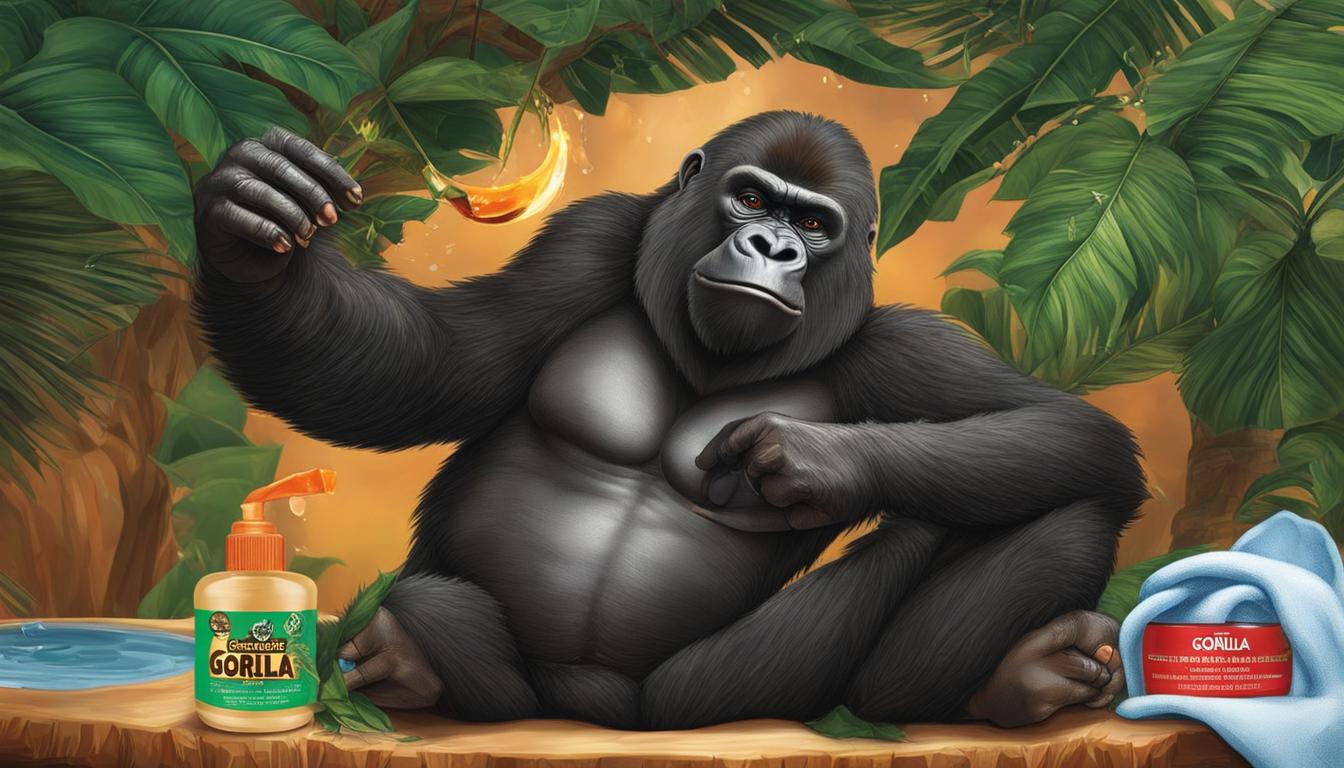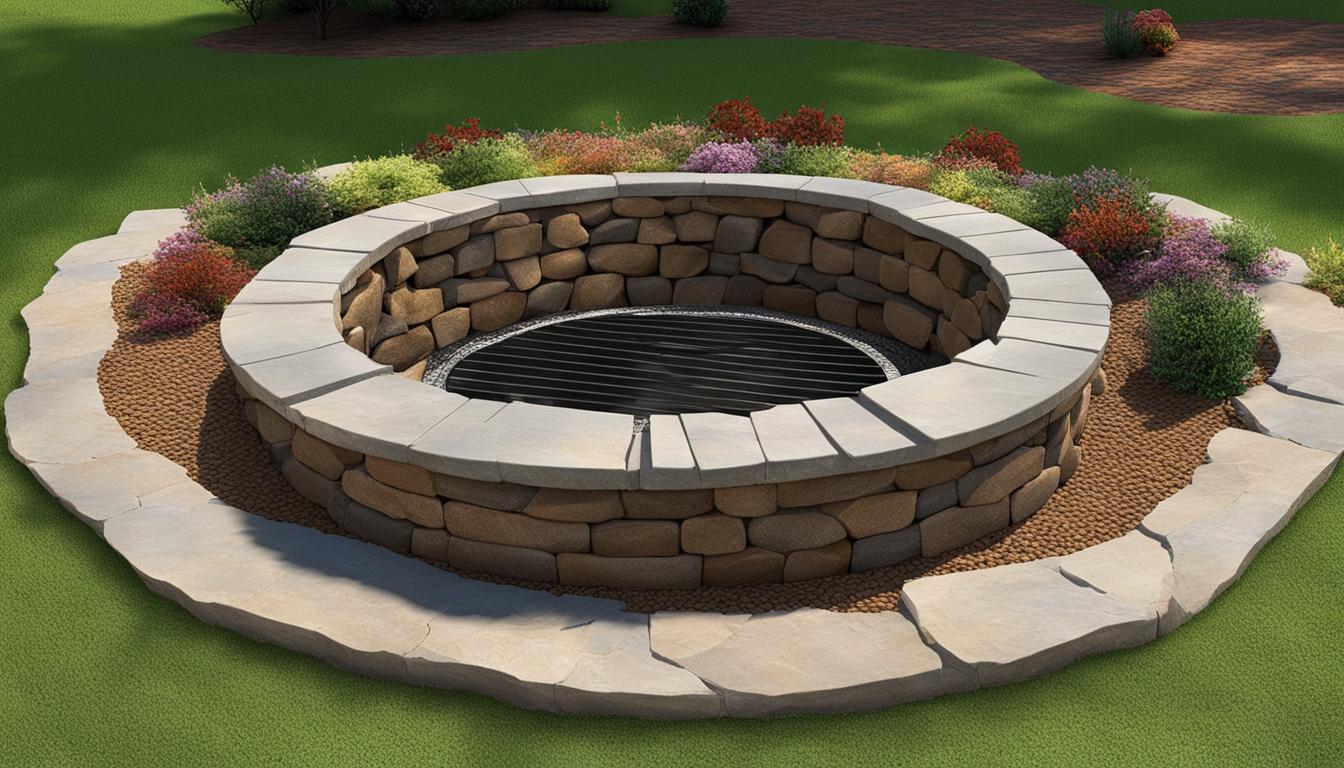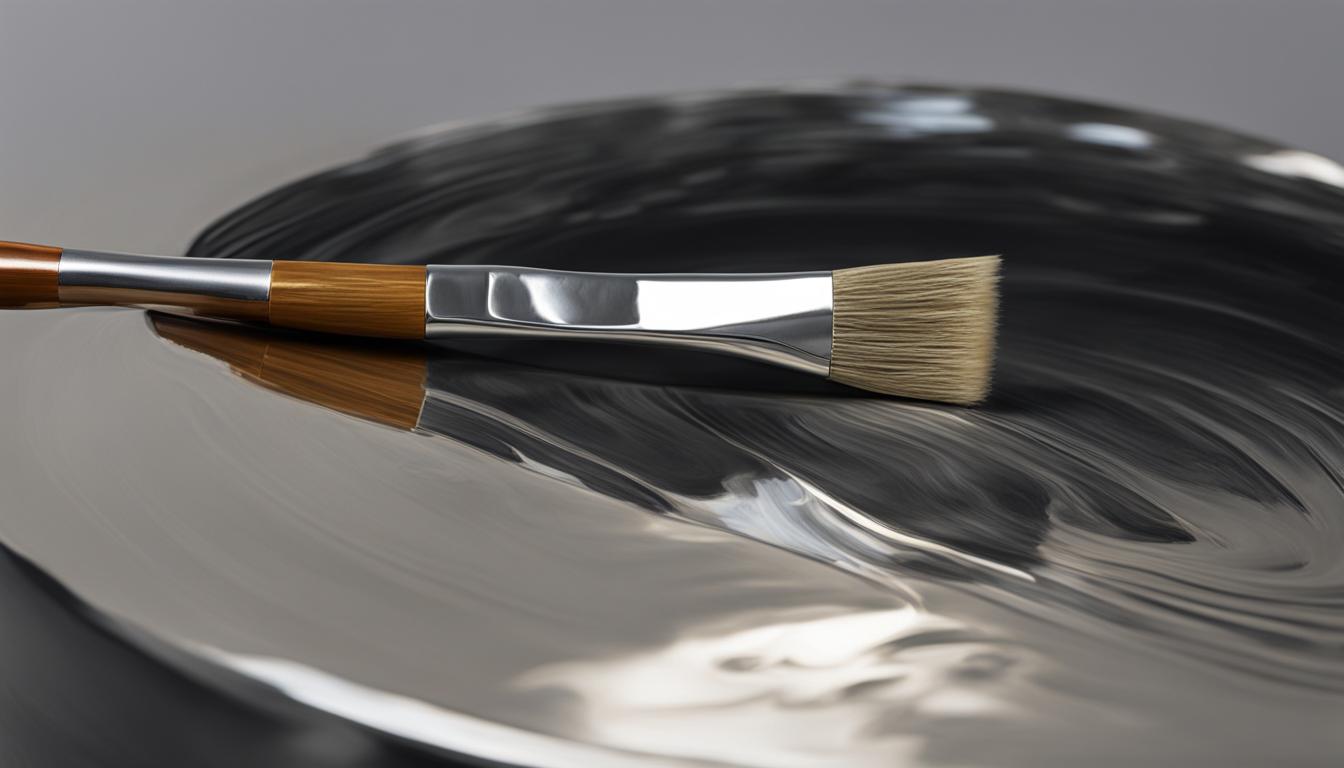Removing Gorilla Glue from skin can be a challenging task, but with the right techniques, it can be done safely and quickly. In this article, I will guide you through step-by-step instructions on how to remove Gorilla Glue from your skin without causing any harm.
Gorilla Glue is a strong adhesive that bonds quickly and firmly. If it accidentally gets on your skin, it can cause discomfort and potentially lead to skin irritation or damage. It is crucial to remove Gorilla Glue from your skin as soon as possible to prevent any adverse effects.
Before attempting to remove Gorilla Glue from your skin, it’s important to take some precautions to ensure your safety. These precautions include wearing protective gloves, ventilating the area, and avoiding the use of harsh chemicals that could further damage your skin.
Follow these steps to safely and effectively remove Gorilla Glue from your skin: Gently wash the affected area with warm, soapy water. Apply an acetone-based nail polish remover or rubbing alcohol to a cotton ball or cloth. Dab the glue-covered skin with the cotton ball or cloth, gently rubbing in circular motions. Continue until the Gorilla Glue starts to loosen and peel off. Rinse the area with water and pat dry. Apply a moisturizer to soothe the skin.
If you prefer not to use acetone-based products, there are alternative methods for removing Gorilla Glue from your skin. These include using olive oil, coconut oil, or petroleum jelly to gently dissolve the adhesive. Simply apply the chosen substance to the affected area, let it sit for a few minutes, and then gently scrape off the glue with a plastic scraper or your fingernail.
Sometimes, even after removing the bulk of the Gorilla Glue, there may be some residue left behind. To deal with stubborn residue, you can use a pumice stone or fine-grit sandpaper to gently exfoliate the affected area. Be sure to moisturize the skin afterwards to prevent dryness or irritation.
To prevent accidental Gorilla Glue mishaps in the future, it’s important to take some precautions. Avoid applying the adhesive near your skin, wear protective gloves when handling it, and work in a well-ventilated area. Additionally, always read and follow the instructions on the Gorilla Glue packaging to ensure safe usage.
In rare cases where Gorilla Glue is deeply embedded in the skin or causing severe discomfort, it may be necessary to seek professional help. If you are unable to remove the glue using home remedies or if you experience any adverse reactions, consult a healthcare professional for guidance and assistance.
Key Takeaways:
- Removing Gorilla Glue from skin requires proper techniques and precautions to prevent skin irritation or damage.
- Gentle washing, acetone-based products, or natural remedies like olive oil can effectively remove Gorilla Glue from skin.
- Stubborn residue can be dealt with using a pumice stone or fine-grit sandpaper, followed by moisturization.
- Preventing future Gorilla Glue mishaps involves taking precautions and following instructions for safe usage.
- If unable to remove Gorilla Glue or experiencing adverse reactions, seek professional help.
Why Removing Gorilla Glue from Skin is Important
Gorilla Glue is an incredibly strong adhesive that forms a strong bond quickly. However, if it accidentally gets on your skin, it can cause various issues, including discomfort, skin irritation, and potential damage.
Removing Gorilla Glue from your skin is of utmost importance to prevent any adverse effects. Not only can the glue cause physical discomfort, but it can also interfere with the natural processes of your skin, leading to potential long-term damage.
“Removing the glue promptly ensures that it does not have the opportunity to penetrate deeper layers of the skin or cause further harm,” explains Dr. Jennifer Miller, a dermatologist.
By removing Gorilla Glue from your skin as soon as possible, you mitigate the risk of developing skin irritation, inflammation, or allergic reactions. Additionally, prompt removal can help minimize the chances of the glue hardening on your skin, making the removal process even more challenging.
Next, let’s explore the precautions you should take before attempting to remove Gorilla Glue from your skin.

Potential Dangers of Gorilla Glue on Skin
| Potential Dangers | Consequences |
|---|---|
| Skin irritation | Redness, itchiness, and discomfort |
| Skin damage | Burning sensation, blisters, or peeling skin |
| Allergic reactions | Rashes or hives |
| Infection | If the adhesive traps bacteria on the skin |
Precautions before Removing Gorilla Glue from Skin
Before attempting to remove Gorilla Glue from your skin, it’s crucial to take certain precautions to ensure your safety and prevent any further damage. By following these safety measures, you can effectively remove Gorilla Glue without harming your skin.
1. Wear Protective Gloves: When handling Gorilla Glue or any adhesive removal products, always wear protective gloves to shield your hands from direct contact with the glue or any potentially harmful chemicals.
2. Ventilate the Area: Ensure that you are in a well-ventilated space before starting the removal process. Proper ventilation helps minimize the inhalation of fumes from adhesive removers or solvents, promoting a safer environment.
3. Avoid Harsh Chemicals: When choosing adhesive removers or solvents, make sure to opt for less harsh options that are gentle on the skin. Avoid using strong chemicals that may further irritate or damage your skin.
4. Test on a Small Area: Before applying any adhesive remover or solvent on a larger area, perform a patch test on a small, inconspicuous area of your skin to check for any adverse reactions or allergies.
5. Follow Product Instructions: Always read and follow the instructions provided on the adhesive remover or solvent packaging. Adhering to the recommended usage guidelines ensures the safe and effective removal of Gorilla Glue from your skin.
By taking these precautions, you can safely remove Gorilla Glue from your skin without causing any harm or discomfort.
Note: Image shows a person wearing protective gloves while removing adhesive.
Step-by-Step Guide on Removing Gorilla Glue from Skin
To safely and effectively remove Gorilla Glue from your skin, follow these step-by-step instructions:
-
Gently wash the affected area with warm, soapy water. This will help loosen the adhesive and prepare the skin for further removal techniques.
-
Apply an acetone-based nail polish remover or rubbing alcohol to a cotton ball or cloth. These solvents help break down the glue and make it easier to remove.
-
Dab the cotton ball or cloth onto the glue-covered skin, gently rubbing in circular motions. This motion helps to work the acetone or alcohol into the adhesive and loosen its grip.
-
Continue rubbing until you start to see the Gorilla Glue loosening and peeling off. Be patient and avoid forcefully pulling the glue, as this can harm your skin.
-
Rinse the area with water to remove any remaining adhesive residue. Pat the skin dry gently with a clean towel.
-
Afterward, apply a moisturizer to soothe the skin and restore its natural moisture balance.
By following these safe techniques, you can effectively remove Gorilla Glue from your skin without causing any harm or irritation.

Alternative Methods for Removing Gorilla Glue from Skin
If you prefer not to use acetone-based products, there are alternative methods for removing Gorilla Glue from your skin. These natural remedies can effectively dissolve the adhesive without harsh chemicals. Here are a few options:
- Olive Oil: Apply a generous amount of olive oil to the affected area. Let it sit for a few minutes to allow the oil to penetrate and soften the glue. Gently scrape off the glue using a plastic scraper or your fingernail.
- Coconut Oil: Similar to olive oil, coconut oil can also help dissolve Gorilla Glue. Apply a small amount of coconut oil to the glue-covered skin and let it sit for a few minutes. Then, carefully scrape off the glue using a plastic scraper or your fingernail.
- Petroleum Jelly: Apply a thick layer of petroleum jelly to the glue on your skin. Allow it to sit for a few minutes to loosen the adhesive. Use a plastic scraper or your fingernail to gently scrape off the glue.
These alternative methods provide a gentler approach to Gorilla Glue removal, using natural ingredients that are readily available. Remember to always be patient and careful when scraping off the glue to avoid damaging your skin.
Professional Tip:
“When using natural remedies for Gorilla Glue removal, it’s important to let the substance sit on the glue for a few minutes to allow it to penetrate and break down the adhesive. This will make the removal process easier and less likely to cause skin irritation.” – Dr. Emily Thompson, Dermatologist

By using these alternative methods, you can safely remove Gorilla Glue from your skin without relying on harsh chemicals. Remember to always test the chosen substance on a small, inconspicuous area of skin before applying it to the glue-covered area, to ensure that you do not have any adverse reactions. Enjoy the benefits of these natural remedies and say goodbye to unwanted Gorilla Glue residue on your skin.
Dealing with Stubborn Gorilla Glue Residue
Sometimes, even after removing the bulk of the Gorilla Glue, there may be some residue left behind. This stubborn residue can be challenging to remove, but with the right techniques, you can successfully eliminate it.
To deal with stubborn Gorilla Glue residue on your skin, you can try the following tips:
- Use a pumice stone: Gently rub the affected area with a pumice stone in circular motions. The abrasive surface of the pumice stone will help exfoliate the residue and gradually remove it.
- Try fine-grit sandpaper: If you don’t have a pumice stone, you can use fine-grit sandpaper instead. Similarly, gently rub the residue with the sandpaper in circular motions until it starts to come off.
Remember to be gentle while using these abrasive methods to avoid causing any discomfort or irritation to your skin. It’s important to moisturize the skin afterwards to prevent dryness and promote healing. You can apply a gentle moisturizer or soothing oil to keep your skin hydrated and nourished.
Keep in mind that these methods are best suited for removing stubborn residue from the skin. If you have Gorilla Glue residue on other surfaces, such as fabric or furniture, it’s recommended to follow the manufacturer’s instructions or consult a professional for appropriate removal techniques.
Comparing Methods for Removing Gorilla Glue Residue
| Method | Pros | Cons |
|---|---|---|
| Pumice stone | – Abrasive surface helps exfoliate residue – Gentle on the skin |
– Requires patience and persistence – May not be suitable for sensitive or injured skin |
| Fine-grit sandpaper | – Effective in removing residue – Readily available |
– Requires caution to prevent skin irritation – May not be suitable for all skin types |
By following these tips and using the appropriate methods, you can effectively tackle stubborn Gorilla Glue residue on your skin. Remember to always prioritize the safety and health of your skin during the removal process.
Preventing Future Accidental Gorilla Glue Mishaps
Gorilla Glue mishaps can easily occur if proper precautions are not taken. To avoid any accidents or incidents involving Gorilla Glue, follow these tips:
- Avoid applying the adhesive near your skin: When using Gorilla Glue, make sure to keep it away from your skin. This will help prevent any accidental contact and minimize the risk of adhesive getting on your skin.
- Wear protective gloves: Whenever handling Gorilla Glue, wear protective gloves to create a barrier between the adhesive and your skin. Gloves provide an extra layer of protection and reduce the chances of the glue sticking to your hands.
- Work in a well-ventilated area: Gorilla Glue can emit strong fumes that may cause discomfort or respiratory irritation. To avoid this, always work in a well-ventilated area. Open windows or use fans to ensure proper air circulation.
- Read and follow the instructions: Before using Gorilla Glue, carefully read the instructions provided on the packaging. Following the recommended usage guidelines will help ensure safe and effective adhesive application.
By implementing these preventive measures, you can significantly reduce the chances of experiencing Gorilla Glue accidents and keep your skin glue-free.
“Prevention is better than cure. Taking proactive steps to prevent Gorilla Glue mishaps is key to a hassle-free experience.” – Me
When to Seek Professional Help
In rare cases where Gorilla Glue is deeply embedded in the skin or causing severe discomfort, it may be necessary to seek professional assistance for gorilla glue removal. If you find yourself unable to remove the glue using home remedies or if you experience any adverse reactions, it is highly recommended to consult a healthcare professional for expert guidance and assistance.
Conclusion
Removing Gorilla Glue from your skin can be a daunting task, but with the right techniques, it can be done safely and effectively. By following the proper steps and precautions, you can remove Gorilla Glue from your skin quickly and painlessly.
First and foremost, it is important to take the necessary precautions before attempting to remove Gorilla Glue from your skin. Wearing protective gloves and working in a well-ventilated area can help ensure your safety throughout the process.
When it comes to removing Gorilla Glue, using acetone-based products such as nail polish remover or rubbing alcohol can be highly effective. Gently rubbing the affected area with a cotton ball or cloth soaked in these solutions can help loosen and remove the adhesive. Alternatively, natural remedies like olive oil, coconut oil, or petroleum jelly can be used to dissolve the glue.
If stubborn residue remains, you can gently exfoliate the area using a pumice stone or fine-grit sandpaper. However, be sure to moisturize the skin afterwards to prevent any dryness or irritation.
Remember, if you encounter any difficulties or adverse reactions, it is always recommended to seek professional help. They can provide guidance and assistance in safely removing Gorilla Glue from your skin. By following these tips and techniques, you can achieve a safe and effective removal of Gorilla Glue from your skin.
FAQ
How do I remove Gorilla Glue from my skin?
To remove Gorilla Glue from your skin, follow these steps: 1) Gently wash the affected area with warm, soapy water. 2) Apply acetone-based nail polish remover or rubbing alcohol to a cotton ball or cloth. 3) Dab the glue-covered skin with the cotton ball or cloth, gently rubbing in circular motions. 4) Continue until the Gorilla Glue starts to loosen and peel off. 5) Rinse the area with water and pat dry. 6) Apply a moisturizer to soothe the skin.
Are there alternative methods for removing Gorilla Glue from skin?
Yes, if you prefer not to use acetone-based products, you can try using olive oil, coconut oil, or petroleum jelly to dissolve the adhesive. Simply apply the chosen substance to the affected area, let it sit for a few minutes, and then gently scrape off the glue with a plastic scraper or your fingernail.
What if there is residue left after removing the Gorilla Glue?
If there is stubborn residue left behind, you can use a pumice stone or fine-grit sandpaper to gently exfoliate the affected area. Be sure to moisturize the skin afterward to prevent dryness or irritation.
How can I prevent Gorilla Glue mishaps in the future?
To prevent accidental Gorilla Glue mishaps, avoid applying the adhesive near your skin, wear protective gloves when handling it, and work in a well-ventilated area. Always read and follow the instructions on the Gorilla Glue packaging to ensure safe usage.
When should I seek professional help for removing Gorilla Glue from my skin?
In rare cases where Gorilla Glue is deeply embedded in the skin or causing severe discomfort, it may be necessary to seek professional help. If you are unable to remove the glue using home remedies or if you experience any adverse reactions, consult a healthcare professional for guidance and assistance.



